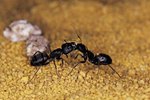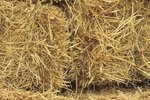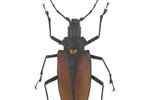
If humans have Georgia on their mind, it often involves fine dining in Atlanta or a lazy scenic walk in Savannah. The warmth in a Georgia day or night can be magical as it grows an abundance of flowers, trees and peaches. Insects also enjoy taking advantage of this eclectic bounty -- especially beetles.
Blister Beetle
Blister beetles come in several colors, including solid black and striped. Their body shape is distinctive from most beetles due the appearance of a neck. Their bodies also contain a toxic compound that causes minor blistering of the skin. They feed on crops including alfalfa and soybeans, and in large numbers their larvae contaminate hay. Horses are especially sensitive to this toxin when ingested. Within 24 hours, horses have shown signs of diarrhea, blood in urine and high fevers, and pregnant females have aborted. In Georgia, blister beetles are most abundant in late summer.
Black Turpentine Beetle
Black turpentine beetles are part of a species known as bark beetles. They're common throughout the southeast and enjoy their Georgia pines. They generally attack pine trees that have been weakened due to storms, drought or overcrowding. They tend to bore at the lower end of the tree, and females initiate the attack. Once the female is successful in getting through the tree’s naturally protective resin, she begins digging galleries within the tree to hold her eggs. The male soon follows this production, and she lays approximately 100 eggs that will hatch in about two weeks.
Flower Beetle
Flower beetles have black to dark brown bodies with a metallic reflection. Although they’re found throughout the southeast as well as Illinois and Texas, little is known about their biology. They are apparently pollen feeders. They also feed on tree sap and fermented sap from decaying or ripe fruit. In large numbers, they are considered pests of corn and roses. In Florida, they have been documented as pests of mangos and avocados, causing a reduction in fruit. They have also been observed invading beehives and damaging combs.
Eyed Click Beetle
Eyed click beetles are common around hardwood trees, such as cherry and oak. They get their name from two large black spots with white rings on their backs. These spots have the appearance of eyes, and help to deter predators. If flipped onto their backs, they have a unique way of righting themselves due to a hinged joint between their head and chest. This joint allows them to arch their back, then push themselves into the air and upright. Their larvae are pests, since they feed on the roots of vegetation such as potatoes, beets and beans.
References
- Insect Identification: Georgia Insects, Bugs and Spiders
- The University of Georgia - College of Agriculture and Environmental Sciences: Blister Beetles in Georgia Alfalfa Hay
- Georgia Forestry Commission: Pine Bark Beetles
- University of Florida: Featured Creatures - Black Turpentine Beetle
- University of Florida: Featured Creatures - A Flower Beetle
- Animal Diversity: Eyed Click Beetle
Photo Credits
-
Hemera Technologies/Photos.com/Getty Images
Writer Bio
Slone Wayking worked as a professional in the veterinary field for 20 years. Though her interest in animal health led to this path, Wayking initially studied creative arts. She has been article writing for more than a year and is currently working towards her degree in multimedia. Her certifications include business writing and basic web design.



